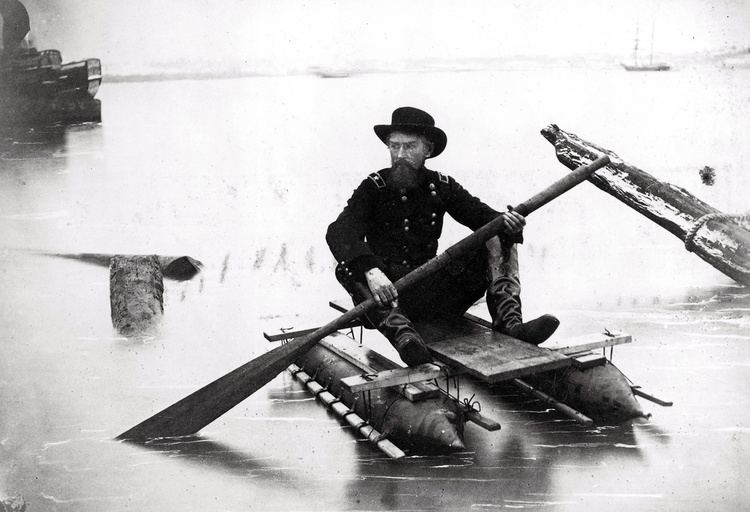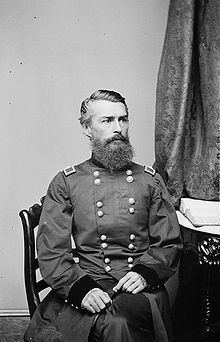Years of service 1835; 1862–1863 Role Civil engineer Name Herman Haupt | ||
 | ||
Born March 26, 1817Philadelphia, Pennsylvania ( 1817-03-26 ) Allegiance United States of AmericaUnion Commands held U.S. Military Railroads Books General theory of bridge construction Service/branch | ||
Herman haupt s aquia line high definition 1080p
Herman Haupt (Philadelphia, March 26, 1817 – Jersey City, December 14, 1905) was an American civil engineer and railroad construction engineer and executive. A Union Army General, he played a key role in the American Civil War, during which he revolutionized U.S. military transportation, particularly the use of railroads.
Contents
- Herman haupt s aquia line high definition 1080p
- Early life
- Civil War
- Postbellum
- In popular media
- Selected works
- References

Early life

Haupt, whose first name was sometimes spelled Hermann, was born in Philadelphia, Pennsylvania, on March 26, 1817, the son of Jacob and Anna Margaretta Wiall Haupt. Jacob, a merchant, died when Herman was 12 years old, leaving Anna to support three sons and two daughters. Herman worked part-time to pay his school tuition, then in 1831 was appointed to the United States Military Academy at the age of 14 by President Andrew Jackson. He graduated in 1835 and was commissioned a second lieutenant in the 3rd U.S. Infantry that July.

He resigned his commission on September 30, 1835, to accept an appointment under Henry R Campbell as Assistant Engineer engaged in the surveys of the Allentown road and of the Norristown & Valley Railroad, which opened in 1835 and 15 years later merged into the Chester Valley railroad.

At 19, he was appointed Assistant Engineer in the state service and located the line from Gettysburg to the Potomac across the South Mountain which is now a part of the Western Maryland.
On August 30, 1838, in Gettysburg, Pennsylvania, he married Ann Cecelia Keller, with whom he would have seven sons and four daughters. In 1839, he designed and patented a novel bridge construction technique known as the Haupt Truss. Two of his Haupt truss bridges still stand in Altoona and Ardmore, Pennsylvania, both from 1854.
From 1840 to 1847, Haupt was a professor of mathematics and engineering at Pennsylvania College. He returned to the railroad business in 1847, becoming a construction engineer on the Pennsylvania Railroad, and then general superintendent from 1849 to 1851. He was the chief engineer of the Southern Railroad of Mississippi from 1851 to 1853, and the chief engineer of the Pennsylvania Railroad until 1856; in the latter position he completed the Mountain Division with the Alleghany Tunnel, opening the line through to Pittsburgh. He was the chief engineer on the five-mile (8 km) Hoosac Tunnel project through the Berkshires in Western Massachusetts from 1856 to 1861.
Civil War
In the spring of 1862, a year after the start of the Civil War, the U.S. War Department organized a new bureau responsible for constructing and operating military railroads in the United States. On April 27, Haupt was appointed chief of the bureau by Secretary of War Edwin M. Stanton, as a colonel and aide-de-camp to major general Irvin McDowell, then in command of the defenses of Washington, D.C. He repaired and fortified war-damaged railroad lines in the vicinity of Washington, arming and training railroad staff, and improved telegraph communications along the railroad lines. Among his most challenging assignments was restoring the strategic Richmond, Fredericksburg and Potomac Railroad line, including the Potomac Creek Bridge, after its partial destruction by Confederate forces. With an inexperienced workforce and other serious impediments, Haupt had the line back in use in under two weeks. President Abraham Lincoln was impressed with Haupt's work there. In a visit on May 28, 1862, he observed: "That man Haupt has built a bridge four hundred feet long and one hundred feet high, across Potomac Creek, on which loaded trains are passing every hour, and upon my word, gentlemen, there is nothing in it but cornstalks and beanpoles."
Haupt was promoted to brigadier general of volunteers on September 5, 1862, but he officially refused the appointment, explaining that he would be happy to serve without official rank or pay, but he did not want to limit his freedom to work in private business (and he privately bridled at the protocols and discipline of Army service). Offered promotion again in early autumn 1863, he hinged his acceptance on three conditions: that a central Bureau of U.S. Military Railroads be established to inspect, direct, and receive reports concerning construction and operation of all military railroads; difficulties with commanding generals be avoided through consultation and cooperation within their departments; the chief of the bureau should be free to move wherever his personal presence was necessary or to attend to whatever public or private business requiring his attention. The War Department declined to accept such terms and Haupt's appointment was eventually rescinded on September 5, 1863, and he left the service on September 14. During that year as a general, however, he made an enormous impact on the Union war effort. The Civil War was one of the first wars in which large-scale railroad transportation was used to move and supply armies rapidly over long distances. He assisted the Union Army of Virginia and Army of the Potomac in the Northern Virginia Campaign, the Maryland Campaign, and was particularly effective in supporting the Gettysburg Campaign, conducted in an area he knew well from his youth. His hastily organized trains kept the Union Army well supplied, and he organized the returning trains to carry thousands of Union wounded to hospitals. After the Battle of Gettysburg, Haupt boarded one of his trains and arrived at the White House on July 6, 1863, being the first to inform President Lincoln that General Robert E. Lee's defeated Confederate army was not being pursued vigorously by Union Major General George G. Meade.
During his service, Haupt developed and implemented "general principles of railroad supply operation" and "also detailed methods of construction and destruction of railroad equipment". His two main principles were that the military should never interfere with the efficient running of the railroad and that rolling stock should be emptied and returned promptly to enable their re-use as transport.
Postbellum
After his war service, Haupt returned to railroad, bridge, pipeline, and tunnel construction. He and his wife purchased a small resort hotel at Mountain Lake in Giles County, Virginia. He invented a drilling machine that won the highest prize of the Royal Polytechnic Society of Great Britain and was the first to prove the practicability of transporting oil in pipes.
He was the general manager of Piedmont Air-Line Railway (from Richmond, Virginia, to Atlanta, Georgia), 1872 to 1876; general manager of the Northern Pacific Railroad, 1881 to 1885; president of the Dakota and Great Southern Railroad, 1885 to 1886. He was a wealthy man from his investments in railroads, mining, and Pennsylvania real estate, but he eventually lost most of his fortune, in part due to political complications involving the completion of the Hoosac Tunnel.
Haupt died of a heart attack at age 88 in Jersey City, New Jersey, stricken while traveling in a Pullman car named "Irma" on a journey from New York to Philadelphia. He is buried in West Laurel Hill Cemetery in Bala Cynwyd, Pennsylvania. His son Lewis M. Haupt was a noted civil engineer.
In popular media
Haupt is a character in the alternate history novels Gettysburg: A Novel of the Civil War and Grant Comes East by Newt Gingrich and William R. Forstchen.
He also appears in the TV miniseries "The Blue and the Gray" by Walter Brooke.
